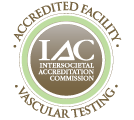Abdominal Aortic Aneurysms Explained
Repair Surgery for Abdominal Aortic Aneurysms
The risk for Abdominal Aortic Aneurysms (AAAs) increases dramatically after the age of 60. As the aneurysms enlarge, they can eventually rupture, and when they do, will almost always result in death. That’s why it is so important to screen for the presence of an AAA, and more so if you have one of the risk factors listed below. Once diagnosed, your healthcare provider will monitor your aneurysms and might suggest that you get it repaired before it reaches a size when it can rupture.
When are you at risk for AAA?
Although it is not clearly known what causes the abdominal walls to weaken and bulge around the belly button (an aneurysm), age and being a male will typically increase the likelihood of it happening. Men are much more likely to develop AAAs than women.
Other risk factors include:
- Age over 60 years
- Smoking
- High blood pressure
- Family history
- Atherosclerosis
- History of heart disease or peripheral arterial disease (PAD)
- Hyperlipidemia (elevated levels of fat in the blood)
- High blood pressure (hypertension)
- Family history of AAA
AAA affects about 5% of males over 65 and has resulted in over 150,000 deaths in 2013. That is why the U.S. Preventive Task Force highly recommends a screening ultrasound for AAA in males over 65 years of age who have ever smoked.
Symptoms and signs of AAA
In many cases, there may be no symptoms of AAA and the aneurysm will only be discovered when it ruptures. Typical signs, if any, include:
- A pulsating feeling in the abdomen, near the navel
- Deep, constant pain in your chest, abdomen, lower back, or flank (over your kidneys), that spreads to the groin, buttocks, or legs
- A “cold foot” or a black or blue painful toe, which can happen if an abdominal aortic aneurysm produces a blood clot that breaks off and blocks blood flow to the legs or feet
- Fever or weight loss, which is typically caused by an inflammatory aortic aneurysm
Getting treated for AAA
Most AAAs are found incidentally during imaging, like a CT scan or ultrasound, performed for another reason. The size of the aneurysm is one of the strongest predictors of whether it is likely to rupture. Aneurysm diameters of greater than 5.5 cm are typically high-risk and recommended for repair surgery.
The repair of AAAs has changed dramatically over the last decade. At The Vascular Experts, patients undergoing endovascular aortic aneurysm repair receive no incisions at all and are subject to very little downtime. Most patients go home the very next day and can immediately return to their normal activities. This is markedly different from the standard, open repair surgical procedure for AAA which was a major surgery with a large incision and required many days spent in the intensive care unit.
The Vascular Experts team relies on their vast experience and state-of-the-art equipment to ensure the best and safest results. Our Board Certified vascular surgeons, have led the way in many of the advances related to the endovascular repair of aortic aneurysms. We were the first team of physicians to fix AAAs without incisions and lead many trials that led to newer, safer treatments. Your doctor will explain the procedure and offer you the opportunity to ask any questions that you might have.
Please contact Dr. Muhs at bmuhs@thevascularexperts.com with any additional questions.
Bart E. Muhs MD, PhD, FACS
Bart E. Muhs MD, PhD, FACS is a Board Certified, internationally respected vascular surgeon who brings a wealth of vascular knowledge and experience to The Vascular Experts. Read more»
Dr. Muhs practices at the Middletown office of The Vascular Experts.



